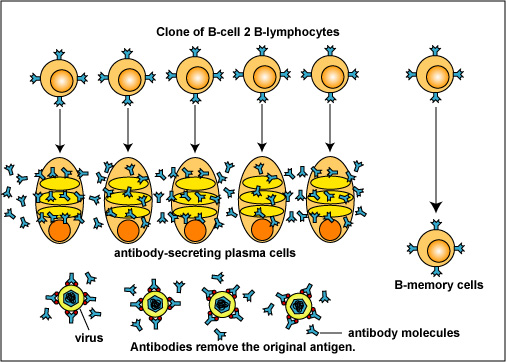13.1F: Anamnestic (Memory) Response
- Page ID
- 3311
- In terms of humoral immunity, statewhat is meant by anamnestic response and discuss its role in immune defense.
- Briefly describe why there is a heightened secondary response during anamestic response.
As a result of B-lymphocytes recognizing T-dependent antigens (proteins) during humoral immunity, numerous circulating B-memory cells and T4-memory cells develop (Figure \(\PageIndex{1}\)), which possess anamnestic response or memory. (During cell-mediated immunity, T8-memory cells also develop.) A subsequent exposure to that same antigen results in:
- A more rapid production of antibodies;
- Produced in greater amounts; and
- Produced for a longer period of time.

The primary response to a new antigen generally peaks at 5-10 days. IgM is made first later to be replaced by IgG. Because of the numerous circulating B-memory cells and T4-memory cells from the primary response, however, the secondary anamnestic response peaks in only 1-3 days (Figure \(\PageIndex{2}\)). There is an increase in the amount of IgG made and under certain conditions, IgA or IgE may be made.

Because of clonal expansion and affinity maturation , there is now a pool of B-memory cells having the "fine-tuned" B-cell receptors on their surface. The pool of B-memory cells migrate to lymph nodes, to mucosal tissue, and circulate in the blood waiting to encounter the original antigen if it again enters the body. B-memory cells have a long life and also replicate and produce antibodies periodically when they are exposed to persisting epitope remaining on the surface of follicular dendritic cells in the lymphoid organs. In addition to the B-memory cells, a pool of circulating T4-effector memory cells (CD4 TEM cells), as well T4 tissue resident memory cells (CD4 TRM cells) located in the mucosa enable an accelerated helper function.
This memory response applies to T-dependent antigens . In the case of the T-independent antigens, there is usually no anamnestic response.
In the case of systemic infections and most vaccinations, many of the plasma cells migrate to the bone marrow where they may continue to secrete antibodies for months or years after the antigen has been eliminated. Plasma cells produced in the mucous membranes generally remain in the mucous membranes and secrete antibodies for only around a year.
Memory is better in preventing systemic infections than preventing mucosal infections because infections limited to the mucous membranes generally do not provide enough time for the development of effector cells such as plasma cells, effector T4-lymphocytes , and cytotoxic T-lymphocytes from the activated memory cells.
Summary
- As a result of B-lymphocytes recognizing T-dependent antigens (proteins) during humoral immunity, numerous circulating B-memory cells and T4-memory cells develop which possess anamnestic response or memory.
- A subsequent exposure to that same antigen results in a more rapid production of antibodies that are produced in greater amounts for a longer period of time.
- The primary response to a new antigen generally peaks at 5 - 10 days.
- Because of the numerous circulating B-memory cells and T4-memory cells from the primary response, the secondary anamnestic response peaks in only 1 - 3 days.
- In the case of systemic infections and most vaccinations, many of the plasma cells migrate to the bone marrow where they may continue to secrete antibodies for months or years after the antigen has been eliminated.
- Plasma cells produced in the mucous membranes generally remain in the mucous membranes and secrete antibodies for only around a year. Therefore, anamnestic response is better at preventing systemic infections than preventing mucosal infections.
Questions
Study the material in this section and then write out the answers to these questions. Do not just click on the answers and write them out. This will not test your understanding of this tutorial.
- In terms of humoral immunity, discusswhat is meant by anamnestic response. (ans)
- Briefly describe why there is a heightened secondary response during anamestic response. (ans)


